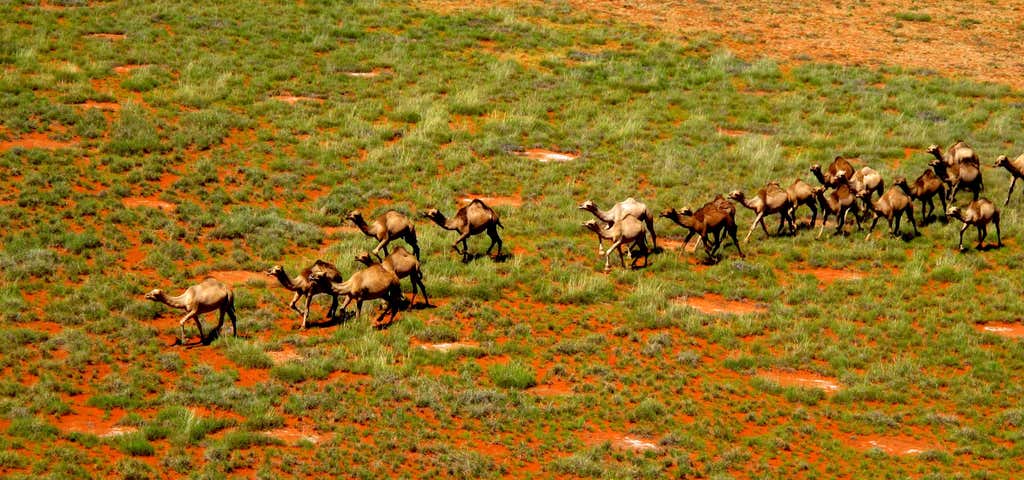Travelling through the Northern Territory is like exploring the past. Jagged red cliffs, expansive desert plains and inviting watering holes create a refuge for prehistoric-looking wildlife. Make reptile-spotting your new hobby as you journey around the state. Look for saltwater and freshwater crocodiles, frill-neck lizards, and the Insta-worthy thorny devils – just a few of the 300 reptile species found here. You may also be lucky to spy over 400 birds, 150 mammals, 50 frog species and 225 freshwater fish. From iconic Australian animals like kangaroos and wallabies, right through to critters whose name you cannot pronounce, there are wonders at every stop.
Watarrka National Park (Kings Canyon)
Desert landscapes attract a different kind of wildlife. Those that thrive in this hostile environment are both biologically and culturally important. With over 20 species of mammals within the region, a sunrise or sundown trip, due to the nocturnal nature of many of these little guys, can net you a glimpse of the mala (a small wallaby known as rufous hare wallaby), euro wallaroo, (a subspecies of kangaroo) greater bilby, and the threatened mulgara. Wildlife spotting is great fun but at Uluru, the animal names make it more so. Eye the woma python, wayuta brush-tailed possum, and the spinifex hopping mouse as well. Tongue teasers or animal names?
Sadly the mala was all but extinct in the wild due to European settlement and predation from cats and foxes in the Northern Territory. But in 2005, after enclosing about 170 hectares of land, mala from nearby Watarrka National Park were released and there are now about 220 mala living in this enclosure.
The greater bilby is also threatened due to habitat loss and feral predation. They too are part of several reintroduction and captive breeding programmes and there is even a National Bilby Day, held the second Sunday of September, to raise funds for conservation projects.
Oh and please don’t forget to look up while you’re here, kestrels, whistling kites, zebra finches, and honeyeaters and roam the skies.
1
The Kangaroo Sanctuary
Australia’s Red Centre has a harsh climate and a hardy landscape which makes it a perfect sanctuary for many wildlife experiences. The 188-acre Kangaroo Sanctuary is a must-see. The owner-led sunset tour with Brolga (or Kangaroo Dundee) gets you as many ‘roo facts as your brain can handle, as well as a very memorable snuggle with some of the dear little kangaroo orphans that they nurture here at the sanctuary. Book in advance, and because the ‘roos come first, all tours are at sunset as kangaroos spend a great deal of their days asleep and the lovely folk at the sanctuary don’t want to disturb them.
2
Alice Springs Reptile Centre
It should come as no surprise that the desert centre of Australia is the perfect home for reptiles. The Reptile Centre exists for you to spot them all in one place. Their extensive display includes a saltwater crocodile, goannas, thorny devils, and some of the world’s most venomous snakes.
3
Alice Springs Desert Park
And for the bird lovers, the Alice Springs Desert Park have a free-flying bird show daily, or you can explore the nocturnal lives of many of the Northern Territories precious little chaps by visiting their Nocturnal House and seeing 30 species in the one place, including the thorny devil, the super cute mala and the long eared little bilby.
4
Newhaven Wildlife Sanctuary
If you’re ready for an adventure, consider the refuge of Newhaven Wildlife Sanctuary. The Newhaven Wildlife Sanctuary is creating the largest non-government feral-cat eradication area and is a refuge for the mala, golden bandicoot, the brush tailed mulgara, the endangered black-footed rock wallaby as well as the great desert skink. Newhaven is also an important arid zone bird watching area as it has 170 bird species living within it’s safe boundaries.
It is run by The Australia Wildlife Conservancy which manages an impressive 4.6 million hectare of land protecting more wildlife than any other organisation, so it’s definitely worth visiting.
This particular reservation, northwest of Alice Springs, is across a sprawling 260,000-hectare site. Journeying to Newhaven requires a 4WD due to rough dirt roads, but once there, you’ll be rewarded with two campsites, ample walks, and six self-drive routes to explore, as well as epic scenery at every turn. There are impressive mountains, sand dunes and salty lakes, mulga woodlands, bloodwood and desert oak forests as well as criter loving spinifex sandplains.
5
Elsey National Park
Famed for the Mataranka Hot Springs, Elsey National Park is a haven for ample amphibians. From northern green tree frogs, rocket frogs, ornate burrowing frogs, and even the infamous cane toad, you can expect to find them around at night. Dive into the water and you may find yourself swimming with freshwater turtles and barramundi. However please avoid swimming in Roper River, as saltwater crocs have been known to hang out here.
Back on land, keep your eyes peeled for curious wandering wallabies and little red flying foxes that hang out in the Bitter Springs campground before dawn and after dusk.
6
Nitmiluk National Park - Katherine Gorge
The stunning thirteen gorges that make up Nitmiluk National Park (aka Katherine Gorge) provide a haven for a plethora of native wildlife, from insects and reptiles to marsupials and mammals, however, exotic birds are the real drawcard here, circling overhead or around the billabongs. So do watch for the endangered red goshawk, Australia’s rarest bird of prey.
If you stay overnight, you can expect to see agile wallabies, flying foxes, wallaroos, echidnas, and even dingoes. But please do be croc-smart in the wet season (October to March) when the harmless freshwater crocodiles are joined by their more aggressive saltwater relatives. And whilst the authorities do move them to other areas, it’s simply not worth getting up close and personal with one of these guys.
7
Magnetic Termite Mounds
The reservation of Litchfield National Park is rife with native fauna. While kangaroos, possums, wallabies, and dingoes call Litchfield home, it’s strangely the hundreds of termite mounds that enthrall visitors the most. These giant structures, some up to 100 years old and between two and three metres high are unique to the northern parts of Australia and Litchfield National Park in particular. The crazy thing about these mounds is that they are enormous magnetic compasses with their thinner sides pointing north-south and the broader sides facing east-west, thus minimising their exposure to the sun, and keeping the mounds cool for the thousands of little termites living within.
8
Litchfield National Park
Like many other parts of the state, where there is water, there are birds and Litchfield acts like an open-air aviary. Stay alert for species such as the rainbow bee-eater, little corella, spangled drongos, and the majestic yellow oriole.
9
Territory Wildlife Park
For a one-stop wildlife adventure, the Territory Wildlife Park cites four days of territory exploration in four hours. Split into three habitats – wetland, monsoon forest, and woodland – exploration of the park is on a 4km loop.
If you visit the wetlands, you can take in the wide variety of bird life - from magpie geese to jacans, green pygmy geese, ibis and herons to name but a few. The best time of year to spot these feathered friends is between July and October, and if you follow the wetland nature trail you will also see turtles and freshwater fish, file snakes and floodplain monitors
Visit the monsoon forest and you may just get a chance to see the shy little guys that rely on the fruiting trees for food and shelter. The Monsoon Vine Forest Walk is a great place to stand and take stock, as well as having the largest domed walk through avarie in the Southern Hemisphere. So if you are a bird lover then this is the place to be. You get here by following a path that wanders through bushland and 11 diverse habitats before lifting you from the forest floor into the treetops - the homes of canopy dwelling birds - before you come back to the ground and can step inside the huge domed avarie.
Take in the bird of prey show on their flight deck, meet wallabies in the woodlands, and come face-to-face (sort of) with a saltwater crocodile. Explore the Nocturnal House in the Woodlands to spy on those nighttime critters who sleep in the heat of the day and only get active when the powerful sun has set.
For children, consider the affordable wildlife encounters or the hands-on KeeperKids program where they can get the opportunity to work alongside the park’s crew.
10
Crocosaurus Cove
Despite Darwin’s proximity to so many national parks, there are still some cool wildlife destinations in the city. For the world’s largest display of Australian reptiles, head to Crocosaurus Cove where thrill-seekers can dive with a huge saltwater crocodile in their Cage of Death. Would you?
11
Aquascene
If donning a snorkel seems like too much work, head to Aquascene, where you can enjoy the nightly fish feeding frenzy. Feed from the fixed platform or wade to get up-close-and- personal with cod, catfish, rays, and more. Alternatively, grab some bread and head to the wharf for a DIY version.
12
Kakadu National Park
If there is an unofficial crocodile capital in Australia, and a place where they are free, it’s Kakadu National Park. While you may spot one of the 10,000 crocs in the wild, it’s safest to observe from a cruise.
The six major landscapes that can be seen throughout Kakadu attract an abundance of wildlife as well so it isn’t just a croc-fest. Look for wallabies, sugar gliders, quolls, and even the flatback turtle. One-third of all Australia’s bird species can be found here, including jabirus, jacanas, spoonbills, and kingfishers.
Knowing when to go wildlife spotting is as important as knowing what animals you’re going to find, so please remember sunrise and sunset are when local wildlife leaves their lair, and water holes provide the best opportunities for glimpses of these guys. But please remember, they are not on a schedule - so do be patient.
Banubanu Wilderness Retreat
If you feel like your own castaway experience (minus Wilson), then consider Bremer Island and the Banubanu Wilderness Retreat. This eco-island - a 15 minute flight from Gove Airport off the northeast coast has no connectivity, so your only option is to relax.
Once on Bremer Island, you can fill your time turtle or bird watching, as East Arnhem Land is celebrated for its natural beaches, abundant sea life, rich Yolgnu culture and lush tropical surrounds. Learn Aboriginal fishing and crabbing techniques as the Gulf of Carpentaria and local reefs are home to Spanish mackerel, jewfish, red emperor and more. Or simply splash around in the sea in these tranquil surrounds as you can swim here without fear of a marine predator leaping out at you mid-stroke!
Banner Photo Credit: Flickr - Dr Fiona J Walsh
Explore More Trip Guides
Western Australia’s Wonderful Wildlife
- 9 Places
- 39:16
- 2,160 mi
Whales, Wonderous Whales. And where to see them Queensland.
- 7 Places
- 25:42
- 1,256 mi
Whales, Wonderous Whales. And where to see them NSW.
- 12 Places
- 18:15
- 926 mi
Queensland And Its Glorious Native Wildlife!
- 12 Places
- 26:35
- 1,344 mi
















